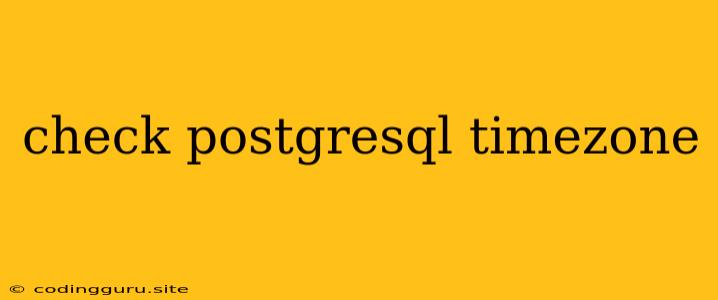Checking PostgreSQL Timezone: A Guide to Ensuring Accurate Timestamps
PostgreSQL, a powerful and versatile open-source relational database system, relies heavily on accurate timestamps for various operations, such as data logging, scheduling, and analysis. A common issue that can arise is discrepancies between the timezone configured in your PostgreSQL instance and the actual timezone you want to work with. This can lead to inaccurate timestamps being stored in your database, potentially causing inconsistencies and errors in your applications.
Why Check the PostgreSQL Timezone?
Before diving into how to check your PostgreSQL timezone, let's understand why it's crucial to do so:
- Data Integrity: Ensuring that your PostgreSQL instance uses the correct timezone is essential for maintaining data integrity. Incorrect timestamps can lead to data misinterpretations and errors in data analysis.
- Application Logic: Many applications rely on accurate timestamps for features like scheduling, time-based calculations, and auditing. A mismatch in timezone can lead to incorrect application behavior.
- Compliance: In some industries, regulations may require specific timezone compliance for data storage and reporting.
How to Check PostgreSQL Timezone
Fortunately, PostgreSQL provides several ways to check the configured timezone:
1. Using SHOW TIME ZONE:
The simplest and most direct method is to use the SHOW TIME ZONE command within your PostgreSQL shell:
SHOW TIME ZONE;
This command will display the current timezone setting for your PostgreSQL instance.
2. Examining the timezone Parameter:
You can also check the timezone parameter setting using the SHOW ALL command:
SHOW ALL;
This command will list all the current settings, including timezone.
3. Querying the pg_catalog.pg_timezone_names Table:
For a more comprehensive list of supported timezones, you can query the pg_catalog.pg_timezone_names table:
SELECT * FROM pg_catalog.pg_timezone_names;
This will provide a list of all available timezone names that you can use in PostgreSQL.
Changing the PostgreSQL Timezone
If you need to adjust the PostgreSQL timezone setting, you can do so using the SET TIME ZONE command:
SET TIME ZONE 'Europe/London';
Replace Europe/London with the desired timezone name.
Tips and Best Practices
- Use standard timezone names: Always use the standard timezone names as defined by the IANA Time Zone Database (TZ Database) for accuracy and consistency.
- Check your application settings: Ensure that your applications are also configured to use the same timezone as your PostgreSQL instance to avoid timezone conflicts.
- Use
CURRENT_TIMESTAMP: Use theCURRENT_TIMESTAMPfunction to capture the current timestamp with the configured timezone. This ensures consistent timestamps in your database.
Troubleshooting
If you are experiencing issues with timezones, here are some common troubleshooting steps:
- Verify the timezone setting: Use the methods described above to double-check your PostgreSQL timezone.
- Check for conflicts: Ensure that there are no conflicts between your PostgreSQL timezone and the timezone settings in your applications.
- Review your application code: Examine your application code to ensure that it correctly handles timezones and converts timestamps as needed.
- Consult documentation: Refer to the PostgreSQL documentation and your application's documentation for detailed information on timezones.
Conclusion
Checking and managing the PostgreSQL timezone is crucial for data integrity, accurate application behavior, and compliance. By using the methods outlined above, you can ensure that your PostgreSQL instance operates with the correct timezone, leading to reliable and consistent timestamp data.
